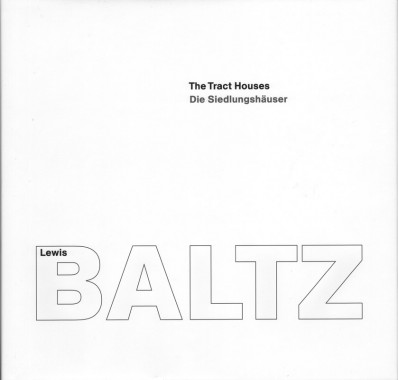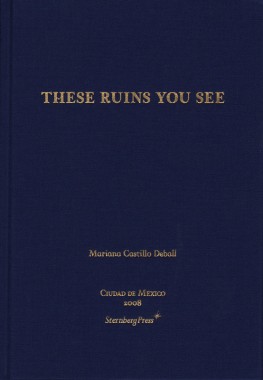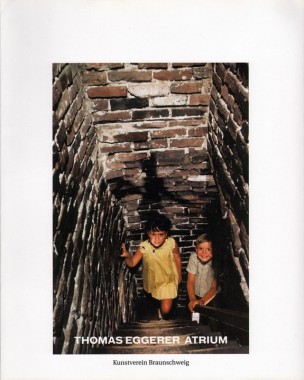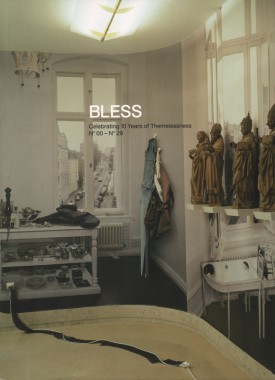
Lewis Baltz, The Tract Houses
Hardcover, 68 pp., offset 1/tritone, 285 x 275 mm
English and German
Edition of 2000
ISBN 0-9703860-4-4
Published by RAM, Steidl
$65.00 ·
Lewis Baltz, with his iconic, minimalist photos of suburban landscape, is considered the founder of the New Topographics movement. Reproduced for the first time, his earliest portfolio, The Tract Houses (1971), and his preliminary forays into a minimal aesthetic, The Prototype Works (1967-1976), illuminate Baltz’s drive to capture the reality of a sprawling Western ecology gone wild. Together with The New Industrial Parks near Irvine, California, this trilogy reveals the indelible importance of Baltz in the development of contemporary photography. “Baltz turned his camera on the virtually featureless built environment of California … He pushed his compositions to an astringent minimum,” writes curator Sheryl Conkelton in an informative essay.
Art, Lewis Baltz, Photography, RAM, Sheryl Conkelton, Steidl, Whitney Museum

Mariana Castillo DeBall, These Ruins You See
Hardcover, 272 pp. + insert, offset 4/1, 155 x 225 mm
English and Spanish
Edition of 2000
ISBN 978-1-933128-46-7
Published by Sternberg Press
$30.00 · out of stock
An amazing book containing a collection of found objects and exhumed artifacts, contemporary and historical illustrations along with thought provoking essays, all looking at the changing ways Mexico has told the story of its past. The various layers of Mexico’s archaeology are forever present, giving rise to continual interpretations, reconstructions, demolitions, and annexations. This volume, based on a number of exhibitions, publications and lectures, brings together the history of collections and exhibitions of pre-Columbian objects, as well as the manufacture of replicas, the shadowy world of forgers and the relocation of key objects, among related themes. This eclectic grouping of ideas brings into sharp relief the ideological baggage and the range of museographic practices that always and inevitably frame our perception of these objects and artifacts.
Hannes Gloor, Manuel Raeder, Mariana Castillo Deball, RAM, Sternberg Press

Aleksandra Mir, Corporate Mentality
Softcover, 256 pp., offset 4/1, 230 x 300 mm
Edition of 2000
ISBN 0-9711193-1-7
Published by Sternberg Press
$40.00 ·
Calling for a reassessment of the function of art in late capitalist society,
Corporate Mentality focuses on the complex and ambiguous ways artistic production inhabits corporate processes, abandoning the autonomy of the artwork in order to elaborate resistant approaches to a world increasingly determined by commercial strategies and market concerns.
Based on an archive (1995–2001) maintained by Aleksandra Mir, it presents a diverse spectrum of artists who take on business as site, as material, and as subject of their work. As Will Bradley writes in frieze, “The book focuses on … an essential area of interest as artists wake up to the reality of the Clinton-era fantasy of ethical corporatism. The plan came out of Mir and Kelsey’s realization that the publicity industry wasn’t stealing artists’ ideas, but simply employing artists, like Mir herself, who needed a day job. ‘Radical’ aesthetics that had taken at least six months to travel (we’re in New York here) from downtown to uptown were now transferred almost instantaneously, causing artists to reassess their methods.”
Absolute Vodka, Anthony Davies, Art, Atelier van Lieshout, Bennett Simpson, Bernadette Corporation, Carey Young, Claude Closky, Daniel Pflumm, Dejanov & Heger, Gareth James, John Kelsey, Lars Bang Larsen, Laura K. Jones, Liam Gillick, Matthieu Laurette, Piotr Uklanski, Purple Institute, RAM, Simon Ford, Sternberg Press, Superflex, Will Bradley

Thomas Eggerer, Atrium
Softcover, 72 pp., offset 4/1, 215 x 270 mm
Edition of 2000
ISBN 978-0-9726806-9-1
Published by Sternberg Press
$30.00 ·
“How can one make a work on canvas today without, in some way, addressing the mobility that now characterizes our most familiar sources of representational surfaces – the television or computer screen with their profusion of data, succeeding, interrupting and, through the hyperlink, opening gaps within one another? Thomas Eggerer’s anti-gravitational paintings address these conditions in a variety of ways, all of which cause a vertiginous loss of grounding.” David Joselit
German artist Thomas Eggerer (*1963) is based in Los Angeles since 1999. A former member of the collaborative Group Material in New York, he initiated conceptual projects in collaboration with Jochen Klein, focusing on identity and gender issues in public space. In his current paintings and drawings, Eggerer continues this discourse with other means. His enigmatic depictions of groups and collectives attempt less to portray the singularity of the individual than to explore the mechanisms of exclusion and inclusion, conformity and hierarchy, as well as the potential of individual or collective utopia.
Art, David Joselit, Diedrich Diederichsen, Karola Grässlin, Kunstverein Braunschweig, RAM, Sternberg Press, Thomas Eggerer

Bernadette Corporation, Eine Pinot Grigio, Bitte
Softcover, 150 pp., offset 4/1, 165 x 240 mm
Edition of 2000
ISBN: 978-1-933128-17-7
Published by Sternberg Press
$25.00 · out of stock
Formed in 1994, the Bernadette Corporation is a creative collective based in New York and Europe and organized around revolving memberships and associations. Its artistic output has ranged from fashion to film and literature, training videos, photography, etc., consistently insisting on the idea that the re-imagined format should inform the subject and give shape to its output. Whereas the first book released by BC was reportedly written by 150 people, in an “exquisite corpse” format, the second “novel,” entitled Be Corpse, is described as “a screenplay that cannot be a film” or “a film that can only be on paper.” A drama in three acts, the text seeks to make the gap between our primordial and contemporary selves collapse on itself, revealing an instinctless body and the brain manifest as the over-stimulated observer. Above all, Be Corpse should be received as the continuation of BC’s indirect, fiercely independent critique of our late capitalist/globalized world.
Art, Bernadette Corporation, Book Works, Fashion, Film, RAM, Sternberg Press

Olivia Plender, A Stellar Key to the Summerland
Softcover, 112 pp., offset 1/1, 140 x 180 mm
Edition of 2000
ISBN: 978-1-870699-86-0
Published by Book Works
$30.00 ·
British artist Olivia Plender’s work is based in historical research, finding idiosyncratic and little-known events, “peculiar pockets of forgotten history that sit awkwardly with the way we live now,” as one observer comments. Her new graphic novel takes us to another of those pockets, the Modern Spiritualist Movement, which began in 1848, a heady mixture of non-conformist religion, politics and popular entertainment presented as a scientific response to the newly industrialized world. The movement’s working-class base linked it to political campaigns, particularly the anti-slavery movement and the campaign for women’s suffrage. By acting as mediums, women found a unique opportunity to give political speeches — in the guise of channeling a spirit — without transgressing social boundaries. Plender, who was a participant in the 2006 Tate Triennial, mimics the techniques of 19th-century pamphlets and combines spiritualist ephemera with interviews in this absorbing work. Part of Book Works Singular Sociology Series.
Art, Book Works, Olivia Plender, RAM

Jeremy Deller and Alan Kane, Folk Archive
Softcover, 158 pp., offset 4/4, 170 x 240 mm
Edition of 2000
ISBN 1-870699-81-5
Published by Book Works
$35.00 ·
“If Pop Art is about liking things, as Andy Warhol said, then folk art is about loving things,” Jeremy Deller. This is a book about the creative life of Britain and the first attempt since the Festival of Britain to document the popular and folk art of the present day. Organized by Jeremy Deller and Alan Kane, Folk Archive: Contemporary Popular Art from the UK, presents a personal selection of objects and actions, containing elements of ambition, humour, pathos and resistance, which present us with invaluable evidence of life in Britain today.
Alan Kane, Art, Book Works, Jeremy Deller, RAM

Shannon Ebner, The Sun As Error
Hardcover, 64 pp., offset 4/1, 11 x 14.5 inches
Edition of 1000
ISBN 978-0-87587-200-1
Published by LACMA
$65.00 ·
The Los Angeles based artist Shannon Ebner extends her exploration of photography, sculpture and language in this remarkable book,
The Sun as Error. In collaboration with Dexter Sinister (design duo David Reinfurt and Stuart Bailey),
The Sun as Error re-investigates the meaning and language of photographs, creating both an open-ended reading of her practice and also rethinking the idea of an artist’s monograph. Far from straightforward, the book interweaves her bodies of work, previously unseen one-off pieces, with the language of technical diagrams, optical illusions, and graphic design. One of the persistent motifs through the book’s sequence is an asterisk and, specifically, one imbued with the legacy of the graphic designer Muriel Cooper. As the first design director for MIT Press and the cofounder of the Visible Language Workshop, Cooper’s legacy for reorienting and repositioning the direction of an artist’s monograph is imaginatively explored in the creative partnership of Dexter Sinister and Shannon Ebner.
Shannon Ebner’s work has been shown in exhibitions including Trace at The Whitney Museum of American Art at Altria (2006), The 2006 California Biennial at The Orange County Museum of Art, Uncertain States of America, at The Serpentine Gallery, London (2006), Learn to Read, at the Tate Modern, London (2007), and the 2008 Whitney Biennial at The Whitney Museum of American Art.
Art, Charlotte Cotton, Dexter Sinister, Graphics, LACMA, Photography, RAM, Shannon Ebner, Stuart Bailey, Theory, Typography, Wallis Annenberg Photography Department

Bless, Celebrating 10 Years of Themelessness, Nº00 — Nº29
Softcover, 496 pp., offset 4/1 + fore-edge printing, 185 x 250 mm
Edition of 2000
ISBN 978-1-933128-15-3
Published by Sternberg Press
out of print
Bless came to fame in the winter of 97/98, when the models of a Martin Margiela fashion show wore Bless wigs made out of fur. Heralded as one of fashion’s most innovative designers, the Paris and Berlin-based duo (Desiree Heiss and Ines Kaag) quickly refused to capitalize on one milieu. Constantly investigating the boundaries of style, Bless slides from fashion to beauty, interior decoration to art exhibition, collaboration with other brands to stylized advertising. Their production, which sits on the fine line between art object and design, high function and high fashion, is always unique and marked by the recycling and adaptation of unexpected items put to use in a totally new way.
Designed by Manuel Raeder, this fully illustrated book features for the first time the wide range of Bless’ activity and documents a unique mode of cultural production.
Bless have exhibited internationally at the 1st berlin biennale (1998/99), Musée d’Art Moderne de la Ville de Paris (1999), Centre Pompidou (2000), Manifesta 4 (2002), Palais de Tokyo (2003), Moderna Museet, Stockholm (2004), and most recently at the Museum Boijmans Van Beuningen, Rotterdam (2006). Their collaborations with other brands range from Adidas to Levi’s, Nike, Mikli and Droog over to the jewellery designer Bucherer.
Adriano Sack, Art, Barbara Steiner, Bless, Culture, Desiree Heiss, Elein Fleiss, Fashion, Graphics, Ines Kaag, Manuel Raeder, Nakako Hayashi, Olivier Zahm, RAM, Stéphanie Moisdon, Sternberg Press, Thimo te Duits, Typography, Ulf Poschardt








